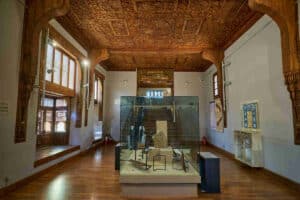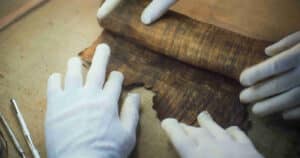The Pharaoh’s Curse is a belief deeply rooted in popular culture, both among Egyptians themselves and foreign travelers visiting the country, especially those from the Anglo-Saxon world. Therefore, you might hear about it during your trip to Egypt. In this post, we briefly explain what it is and the origin of this myth.
A Belief Based on Superstition
Although it has been popularized as the Pharaoh’s Curse, it is actually associated not only with the tombs of pharaohs but with those of any other individual from Ancient Egypt. According to the hieroglyphic inscriptions on some sarcophagi, warnings were issued to those who dared to desecrate the tomb and steal, damage, or in any way disturb the tomb’s owner, who would be watching everything from the afterlife. These warnings indicated that offenders might experience some negative event or even death, often invoking deities like Hemen, Sekhmet, or Thoth.
It’s important to remember that the deciphering of hieroglyphs did not occur until 1822, by the Frenchman Champollion. But even before that time, there was already a belief in curses linked to the theft of mummies or items from tombs. Therefore, its origin is somewhat superstitious, which was later substantiated.
However, despite being a superstition, some reputable scientists prefer not to tempt fate in this regard. This is the case, for example, with the famous archaeologist Zahi Hawass, who claims to have experienced nightmares linked to certain sarcophagus excavations and, since then, prefers to disturb the mummies as little as possible.
Tutankhamun Accelerated Everything
The reason we know this belief as the Pharaoh’s Curse is due to the discovery of Tutankhamun’s tomb in 1922. Led by Howard Carter, a large team of archaeologists and other professionals, exceeding fifty people, participated in this discovery.
The British press at the time, of dubious rigor, and subsequent science fiction writers fueled the belief that in the following years, people involved in the discovery were victims of the Pharaoh’s Curse, angered by the desecration of his tomb.
According to various reports, some members of the expedition died under strange circumstances, without a clear medical explanation, or saw existing health problems accelerate until they died, like the patron who financed the work: Lord Carnarvon. However, the vast majority of the discovery team experienced no issues, and Carter himself died almost two decades later.
There’s also no clear evidence that Tutankhamun’s tomb had any specific curse written, although some reports mention a supposed ostracon with this purpose.
A Curse That Could Backfire
Finally, it should be noted that these curses are relatively rare in Ancient Egypt. Despite the extensive knowledge of numerous tombs of pharaohs and other figures in that society, the vast majority lack writings with this purpose. Among other reasons because, in that civilization, there was a belief that such a curse could backfire on its author or the deceased associated with it.
Therefore, to date, relatively few examples have been found, like in the tomb of Antef, a nomarch from the times of the 11th dynasty. However, some of them are quite explicit, like the following, reported by Hawass in one of his books regarding the burials in the Valley of the Kings in Luxor:
Cursed be those who disturb the rest of a Pharaoh. Those who break the seal of this tomb will meet death by a disease that no doctor can diagnose.




